
The Detroit Masonic Temple is the world's largest Masonic Temple. Located in the Cass Corridor neighborhood of Detroit, Michigan, at 500 Temple Street, the building serves as a home to various masonic organizations including the York Rite Sovereign College of North America. The building contains a variety of public spaces including three theaters, three ballrooms and banquet halls, and a 160 by 100 feet clear-span drill hall.
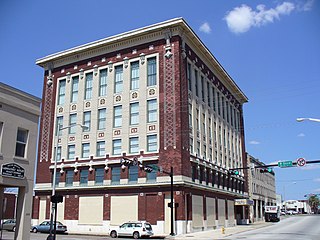
The Masonic Temple is a historic Masonic temple in Jacksonville, Florida. It is located at 410 Broad Street. Constructed by the Grand Lodge between 1901 and 1912, it was added to the U.S. National Register of Historic Places on September 22, 1980.

The Grand Opera House, also known as The Grand or Masonic Hall and Grand Theater, is a 1,208-seat theater for the performing arts in Wilmington, Delaware, United States. The four-story building was built in 1871 by the Delaware Grand Lodge of Masons to serve as a Masonic Temple and auditorium. The construction cost was $100,000. It was designed in Second Empire style by Baltimore architect Thomas Dixon and incorporates symbolism from Freemasonry into the cast-iron facade. Its central pediment contains an Eye of Providence.
Grand Army of the Republic Hall, GAR Building, or variants thereof, may refer to:

The Clearwater Masonic and Grand Army of the Republic Hall is a historic building in Clearwater, Minnesota, United States, constructed in 1888. It has served as a meeting hall for both a local Grand Army of the Republic (GAR) post, and a local Masonic Lodge, with commercial space on the ground floor. It was listed on the National Register of Historic Places in 1979 under the name Clearwater Masonic Lodge–Grand Army of the Republic Hall for having local significance in the themes of architecture and social history. It was nominated for its association with the fraternal organizations of Clearwater and many other rural Wright County communities that, in the words of historian John J. Hackett, "provided leadership, direction, and contributions to the county's political, educational, patriotic, and social life."
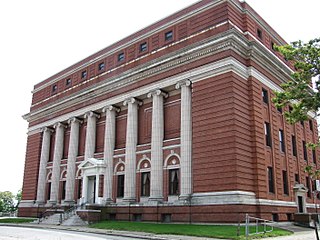
The Worcester Masonic Temple is a historic Masonic temple Located at 1 Ionic Avenue in downtown Worcester, Massachusetts. Construction on the temple began on September 12, 1913, with the laying of the cornerstone. The building was finished and dedicated on September 3, 1914, by the then Grand Master, Most Worshipful Melvin M. Johnson.

Watertown Masonic Temple is a historic building and former Masonic hall located in Watertown in Jefferson County, New York. It was constructed in 1914 as a meeting hall for a local Masonic lodge and is a three-story building in the Neoclassical style, with a masonry and steel structure. The front of the building features a large prostyle temple front with six Doric columns supporting a triangular pediment. It was listed on the National Register of Historic Places in 1980.
The Hobart Masonic Hall is a historic building located in the village of Hobart in Delaware County, New York, United States. It was originally constructed in 1889 as a meeting hall for St. Andrews Lodge No. 289 of Freemasons, although it is no longer used for that purpose.

The Masonic Temple in Kalamazoo, Michigan, is a building from 1913. It was listed on the National Register of Historic Places in 1980. No lodges currently meet in the building.
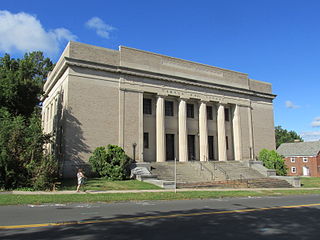
Temple B'Nai Israel is an historic former Jewish synagogue and former Masonic hall, located at 265 West Main Street in New Britain, Connecticut, in the United States.
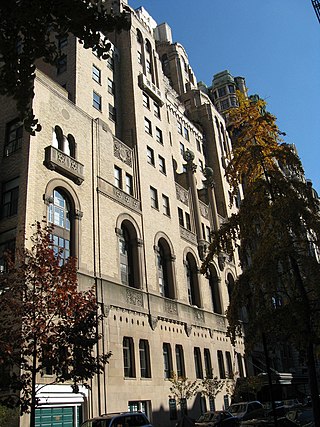
The Level Club is a residential building at 253 West 73rd Street on the Upper West Side of Manhattan in New York City. It was built as a men's club by a group of Freemasons in 1927; it served this original function for just about three years. Afterwards, the building was used, in turn, as a hotel and a drug re-hab center. It has now been remodeled as a condominium.
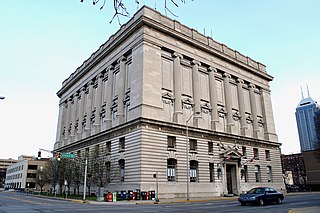
The current Indianapolis Masonic Temple, also known as Indiana Freemasons Hall, is a historic Masonic Temple located at Indianapolis, Indiana. Construction was begun in 1908, and the building was dedicated in May 1909. It is an eight-story, Classical Revival style cubic form building faced in Indiana limestone. The building features rows of engaged Ionic order columns. It was jointly financed by the Indianapolis Masonic Temple Association and the Grand Lodge of Free and Accepted Masons of Indiana, and was designed by the distinguished Indianapolis architectural firm of Rubush and Hunter.

The Brewster Building is a historic commercial building and IOOF Hall located at 201 Fourth Street in Galt, California. It was built in 1882 and was listed on the National Register of Historic Places in 2000.
The Flowers Building is a historic building constructed in 1902 in Columbus, Georgia. Its Chicago style design is by architect T. Firth Lockwood. It was listed on the National Register of Historic Places in 1980. It has also been known as the Flowers Building.
The Kennett City Hall and Masonic Lodge, is a historic building located at Kennett, Dunklin County, Missouri, USA. It has also been known as the Dunklin County Museum. As originally constructed in 1903, the first floor was used exclusively as Kennett's City Hall and the second floor was occupied by several local Masonic organizations. The Masons moved to a new building in the 1950s, and in 1976 the city vacated the premises as well.

The Riverside Avenue Historic District is a 16.5 acres (6.7 ha) historic district in Downtown Spokane, Washington consisting of buildings constructed in the early 20th century, and was listed on the National Register of Historic Places in 1976. The listing includes 14 contributing properties, nine of which are considered primary and five are considered secondary.

Rudolph Zerses Gill was an American architect and builder of the classical revival style that has designed several municipal buildings, club halls, and private residences in Illinois, Missouri, Kentucky and Tennessee. A few have been nominated to the National Register of Historic Places (NRHP).














